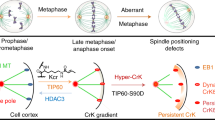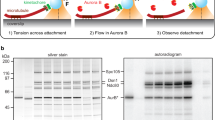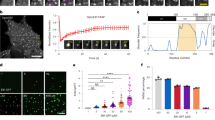Abstract
During mitosis, kinetochores form persistent attachments to microtubule tips and undergo corrective detachment in response to phosphorylation by Ipl1 (Aurora B) kinase1. The Dam1 complex is required to establish and maintain bi-oriented attachment to microtubule tips in vivo, and it contains multiple sites phosphorylated by Ipl1 (Refs 2, 3, 4, 5, 6, 7, 8, 9, 10). Moreover, a number of kinetochore-like functions can be reconstituted in vitro with pure Dam1 complex11,12,13,14. These functions are believed to derive from the ability of the complex to self-assemble into rings12,13,15,16,17. Here we show that rings are not necessary for dynamic microtubule attachment, Ipl1-dependent modulation of microtubule affinity or the ability of Dam1 to move processively with disassembling microtubule tips. Using two fluorescence-based assays, we found that the complex exhibited a high affinity for microtubules (Kd of approximately 6 nM) that was reduced by phosphorylation at Ser 20, a single Ipl1 target residue in Dam1. Moreover, individual complexes underwent one-dimensional diffusion along microtubules and detached 2.5-fold more frequently after phosphorylation by Ipl1. Particles consisting of one to four Dam1 complexes — too few to surround a microtubule — were captured and carried by disassembling tips. Thus, even a small number of binding elements could provide a dynamic, phosphoregulated microtubule attachment and thereby facilitate accurate chromosome segregation.
This is a preview of subscription content, access via your institution
Access options
Subscribe to this journal
Receive 12 print issues and online access
$209.00 per year
only $17.42 per issue
Buy this article
- Purchase on Springer Link
- Instant access to full article PDF
Prices may be subject to local taxes which are calculated during checkout





Similar content being viewed by others
References
Pinsky, B. A., Kotwaliwale, C. V., Tatsutani, S. Y., Breed, C. A. & Biggins, S. Glc7/protein phosphatase 1 regulatory subunits can oppose the Ipl1/aurora protein kinase by redistributing Glc7. Mol. Cell Biol. 26, 2648–2660 (2006).
Tanaka, K., Kitamura, E., Kitamura, Y. & Tanaka, T. U. Molecular mechanisms of microtubule-dependent kinetochore transport toward spindle poles. J. Cell Biol. 178, 269–281 (2007).
Franco, A., Meadows, J. C. & Millar, J. B. The Dam1/DASH complex is required for the retrieval of unclustered kinetochores in fission yeast. J. Cell Sci. 120, 3345–3351 (2007).
Cheeseman, I. M., Enquist-Newman, M., Muller-Reichert, T., Drubin, D. G. & Barnes, G. Mitotic spindle integrity and kinetochore function linked by the Duo1p/Dam1p complex. J. Cell Biol. 152, 197–212 (2001).
He, X., Rines, D. R., Espelin, C. W. & Sorger, P. K. Molecular analysis of kinetochore–microtubule attachment in budding yeast. Cell 106, 195–206 (2001).
Janke, C., Ortiz, J., Tanaka, T. U., Lechner, J. & Schiebel, E. Four new subunits of the Dam1-Duo1 complex reveal novel functions in sister kinetochore biorientation. EMBO J. 21, 181–193 (2002).
Jones, M. H., He, X., Giddings, T. H. & Winey, M. Yeast Dam1p has a role at the kinetochore in assembly of the mitotic spindle. Proc. Natl Acad. Sci. USA 98, 13675–13680 (2001).
Li, Y. et al. The mitotic spindle is required for loading of the DASH complex onto the kinetochore. Genes Dev. 16, 183–197 (2002).
Cheeseman, I.M. et al. Phospho-regulation of kinetochore-microtubule attachments by the Aurora kinase Ipl1p. Cell 111, 163–172 (2002).
Shimogawa, M. M. et al. Mps1 phosphorylation of Dam1 couples kinetochores to microtubule plus ends at metaphase. Curr. Biol. 16, 1489–1501 (2006).
Asbury, C. L., Gestaut, D. R., Powers, A. F., Franck, A. D. & Davis, T. N. The Dam1 kinetochore complex harnesses microtubule dynamics to produce force and movement. Proc. Natl Acad. Sci. USA 103, 9873–9878 (2006).
Westermann, S. et al. Formation of a dynamic kinetochore– microtubule interface through assembly of the Dam1 ring complex. Mol. Cell 17, 277–290 (2005).
Westermann, S. et al. The Dam1 kinetochore ring complex moves processively on depolymerizing microtubule ends. Nature 440, 565–569 (2006).
Franck, A.D. et al. Tension applied through the Dam1 complex promotes microtubule elongation providing a direct mechanism for length control in mitosis. Nature Cell Biol. 9, 832–837 (2007).
Miranda, J. J., De Wulf, P., Sorger, P. K. & Harrison, S. C. The yeast DASH complex forms closed rings on microtubules. Nature Struct. Mol. Biol. 12, 138–143 (2005).
Miranda, J. J., King, D. S. & Harrison, S. C. Protein arms in the kinetochore–microtubule interface of the yeast DASH complex. Mol. Biol. Cell 18, 2503–2510 (2007).
Wang, H.W. et al. Architecture of the Dam1 kinetochore ring complex and implications for microtubule-driven assembly and force-coupling mechanisms. Nature Struct. Mol. Biol. 14, 721–726 (2007).
Howard, J. & Hyman, A. A. Microtubule polymerases and depolymerases. Curr. Opin. Cell Biol. 19, 31–35 (2007).
Westermann, S., Drubin, D. G. & Barnes, G. Structures and functions of yeast kinetochore complexes. Ann. Rev. Biochem. 76, 563–591 (2007).
Karp, G. Cell and Molecular Biology, 5th edn (John Wiley & Sons, Hoboken, 2007).
Hill, T. L. Theoretical problems related to the attachment of microtubules to kinetochores. Proc. Natl Acad. Sci. USA 82, 4404–4408 (1985).
Koshland, D. E., Mitchison, T. J. & Kirschner, M. W. Polewards chromosome movement driven by microtubule depolymerization in vitro. Nature 331, 499–504 (1988).
Molodtsov, M. I., Grishchuk, E. L., Efremov, A. K., McIntosh, J. R. & Ataullakhanov, F. I. Force production by depolymerizing microtubules: a theoretical study. Proc. Natl Acad. Sci. US A 102, 4353–4358 (2005).
Efremov, A., Grishchuk, E. L., McIntosh, J. R. & Ataullakhanov, F. I. In search of an optimal ring to couple microtubule depolymerization to processive chromosome motions. Proc. Natl Acad. Sci. USA 104, 19017–19022 (2007).
Dong, Y., Vanden Beldt, K. J., Meng, X., Khodjakov, A. & McEwen, B. F. The outer plate in vertebrate kinetochores is a flexible network with multiple microtubule interactions. Nature Cell Biol. 9, 516–522 (2007).
McIntosh, J. R. Rings around kinetochore microtubules in yeast. Nature Struct. Mol. Biol. 12, 210–212 (2005).
Enquist-Newman, M. et al. Dad1p, third component of the Duo1p/Dam1p complex involved in kinetochore function and mitotic spindle integrity. Mol. Biol. Cell 12, 2601–2613 (2001).
Cheeseman, I.M. et al. Implication of a novel multiprotein Dam1p complex in outer kinetochore function. J. Cell Biol. 155, 1137–1145 (2001).
Cantor, C. R. & Schimmel, P. R. Biophysical Chemistry, Vol. I, II and III. (W. H. Freeman & Company, San Francisco; 1980).
McGhee, J. D. & von Hippel, P. H. Theoretical aspects of DNA-protein interactions: co-operative and non-co-operative binding of large ligands to a one-dimensional homogeneous lattice. J. Mol. Biol. 86, 469–489 (1974).
Pinsky, B. A., Kung, C., Shokat, K. M. & Biggins, S. The Ipl1–Aurora protein kinase activates the spindle checkpoint by creating unattached kinetochores. Nature Cell Biol. 8, 78–83 (2006).
Shang, C. et al. Kinetochore protein interactions and their regulation by the Aurora kinase Ipl1p. Mol. Biol. Cell 14, 3342–3355 (2003).
Cheeseman, I. M., Chappie, J. S., Wilson-Kubalek, E. M. & Desai, A. The conserved KMN network constitutes the core microtubule-binding site of the kinetochore. Cell 127, 983–997 (2006).
Davis, T. N. & Wordeman, L. Rings, bracelets, sleeves, and chevrons: new structures of kinetochore proteins. Trends Cell Biol. 17, 377–382 (2007).
Gunawardane, R. N., Zheng, Y., Oegema, K. & Wiese, C. Purification and reconstitution of Drosophilia γ-tubulin complexes. in Methods in Cell Biology, Vol. 67 (eds. Palazzo, R. E.& Davis, T. N.) 1–26 (Academic Press, San Diego; 2001).
Press, W. H., Vetterling, W. T., Teukolsky, S. A. & Flannery, B. P. Numerical Recipes in C: The Art of Scientific Computing, 2nd edn (Cambridge University Press, Cambridge, 1996).
Hill, A. The possible effects of the aggregation of the molecules of haemoglobin on its dissociation curves. J. Physiol. 40, iv–vii (1910).
Rice, S. et al. A structural change in the kinesin motor protein that drives motility. Nature 402, 778–784 (1999).
Acknowledgements
We thank J. J. Miranda and S. C. Harrison (Harvard Medical School) for providing the expression plasmid for the Dam1 complex and M. Wagenbach for providing MCAK–GFP. We also thank A. Franck, A. Powers, S. Biggins and J. Stumpff for helpful scientific discussion. This work was supported by an NSF IGERT traineeship to J.C., Searle Scholar Award 06-L-111 (to C. L. A.), Packard Fellowship for Science and Engineering No. 2006-30521 (to C. L. A.), and by grants R01GM40506, R01GM79373 and R01GM69429 from the National Institute of General Medical Sciences (to T. N. D., C. L. A. and L. W., respectively)
Author information
Authors and Affiliations
Contributions
D. R. G., B. G., L. W., C. L. A. and T. N. D. planned the experiments; D. R. G., B. G., J. C., P. O. W., A. Z. and T. N. D. performed the experimental work; D. R. G., B. G., C. L. A. and T. N. D. performed the data analysis; D. R. G., C. L. A. and T. N. D. prepared the manuscript.
Corresponding author
Supplementary information
Supplementary Information
Supplementary Figure S1 (PDF 313 kb)
Supplementary Information
Supplementary Movie 1 (MOV 7180 kb)
Supplementary Information
Supplementary Movie 2 (MOV 7046 kb)
Supplementary Information
Supplementary Movie 3 (MOV 6699 kb)
Supplementary Information
Supplementary Movie 4 (MOV 571 kb)
Supplementary Information
Supplementary Movie 5 (MOV 9511 kb)
Supplementary Information
Supplementary Movie 6 (MOV 1978 kb)
Supplementary Information
Supplementary Movie 7 (MOV 5837 kb)
Rights and permissions
About this article
Cite this article
Gestaut, D., Graczyk, B., Cooper, J. et al. Phosphoregulation and depolymerization-driven movement of the Dam1 complex do not require ring formation. Nat Cell Biol 10, 407–414 (2008). https://doi.org/10.1038/ncb1702
Received:
Accepted:
Published:
Issue Date:
DOI: https://doi.org/10.1038/ncb1702
This article is cited by
-
Anillin propels myosin-independent constriction of actin rings
Nature Communications (2021)
-
Regulation of kinetochore configuration during mitosis
Current Genetics (2018)
-
The molecular architecture of the Dam1 kinetochore complex is defined by cross-linking based structural modelling
Nature Communications (2015)
-
Kinetochores require oligomerization of Dam1 complex to maintain microtubule attachments against tension and promote biorientation
Nature Communications (2014)
-
“Uno, nessuno e centomila”: the different faces of the budding yeast kinetochore
Chromosoma (2014)



